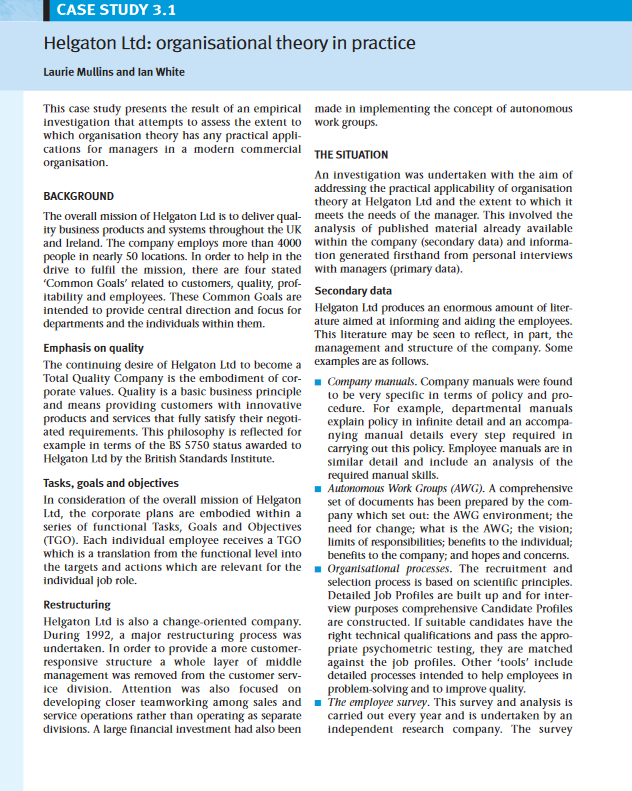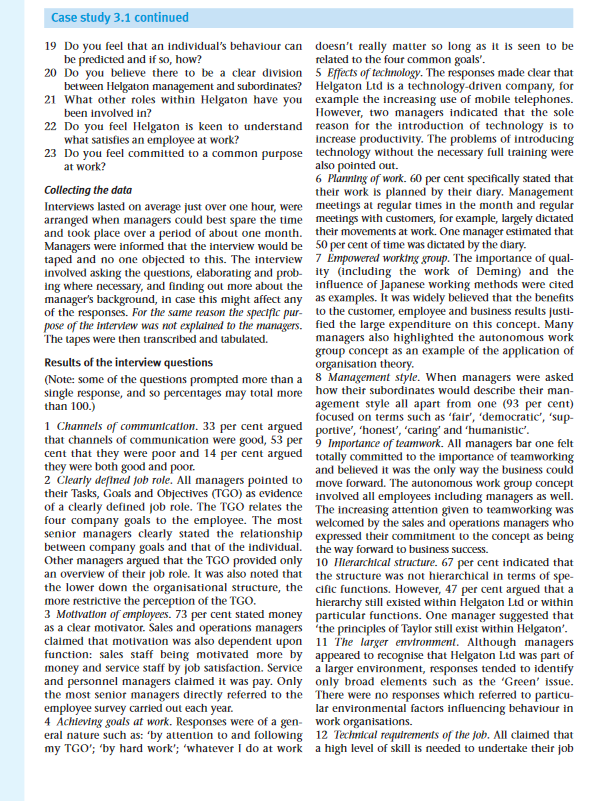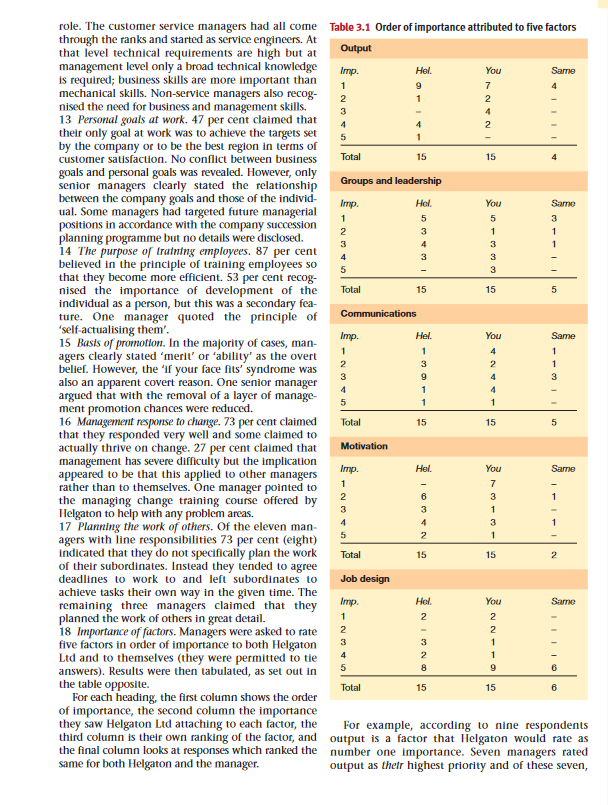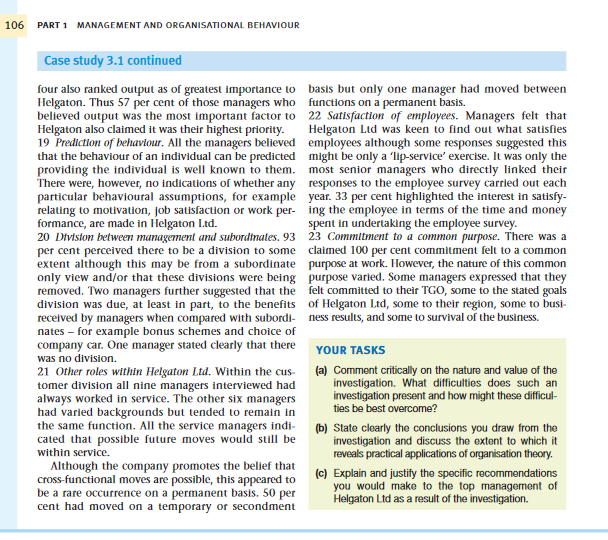Question
From the attached Helgaton Ltd: organizational theory in practice from Chapter Three (pages 102-106) (a) Comment critically on the nature and value of the investigation.





From the attached "Helgaton Ltd: organizational theory in practice" from Chapter Three (pages 102-106)
(a) Comment critically on the nature and value of the investigation. What difficulties does such an investigation present and how might these difficulties be best overcome?
(b) State clearly the conclusions you draw from the investigation and discuss the extent to which it reveals practical applications of organisation theory.
(c) Explain and justify the specific recommendations you would make to the top management of Helgaton Ltd as a result of the investigation.
This case study presents the result of an empirical made in implementing the concept of autonomous investigation that attempts to assess the extent to work groups. which organisation theory has any practical applications for managers in a modern commercial THE SITUATION organisation. An investigation was undertaken with the aim of BACKGROUND addressing the practical applicability of organisation theory at Helgaton Ltd and the extent to which it The overall mission of Helgaton L.td is to deliver qual- meets the needs of the manager. This involved the ity business products and systems throughout the UK analysis of published material already available. and Ireland. The company employs more than 4000 within the company (secondary data) and informapeople in nearly 50 locations. In order to help in the tion generated firsthand from personal interviews drive to fulfil the mission, there are four stated with managers (primary data). 'Common Goals' related to customers, quality, profitability and employees. These Common Goals are intended to provide central direction and focus for Helgaton Ltd produces an enormous amount of literdepartments and the individuals within them. ature aimed at informing and aiding the employees. Emphasisonqualitymanagementandstructureofthecompany.SomeThisliteraturemaybescentoreflect,inpart,the The continuing desire of Helgaton Ltd to become a examples are as follows. Total Quality Company is the embodiment of cor- Company manuals. Company manuals were found porate values. Quality is a basic business principle to be very specific in terms of policy and proand means providing customers with innovative cedure. For example, departmental manuals products and services that fully satisfy their negoti- explain policy in infinite detail and an accompaated requirements. This philosophy is reflected for nying manual details every step required in example in terms of the BS 5750 status awarded to carrying out this policy. Fmployee manuals are in Helgaton Ltd by the British Standards Institute. similar detail and include an analysis of the Tasks,goalsandobjectives-AutonomousWorkGroups(AWG).Acomprehensiverequiredmanualskills. In consideration of the overall mission of Helgaton set of documents has been prepared by the comL.td, the corporate plans are embodied within a pany which set out: the AWG environment; the series of functional Tasks, Goals and Objectives need for change; what is the AWG; the vision; (TGO). Each individual employee receives a TGO limits of responsibilities; benefits to the individual; which is a translation from the functional level into benefits to the company; and hopes and concerns. the targets and actions which are relevant for the rganisational processes. The recruitment and individual job role. selection process is based on scientific principles. Restructuring Detailed Job Profiles are built up and for interHelgaton Ltd is also a change-oriented company. are constructed. If suitable candidates have the During 1992, a major restructuring process was right technical qualifications and pass the approundertaken. In order to provide a more customer- priate psychometric testing, they are matched responsive structure a whole layer of middle against the job profiles. Other 'tools' include management was removed from the customer serv- detailed processes intended to help employees in ice division. Attention was also focused on problem-solving and to improve quality. developing closer teamworking among sales and The employee survey. This survey and analysis is service operations rather than operating as separate carried out every year and is undertaken by an divisions. A large financial investment had also been independent research company. The survey CHAPTER 3 APPROACHES TO ORGANISATION AND MANAGEMENT involves a wide range of questions related to sub- Pilot study jects such as management systems and styles; In order to test the reliability of the interview, a working conditions; training; career develop- pilot study was undertaken involving a representament; pay; benefits; job security; team spirit; and tive member of the population. This pilot study overall job satisfaction. highlighted two major issues. The same research company also provides a compar- = Many of the questions were either too open or ative analysis related to other companies that they too closed and needed to be refined. survey. Results of the survey are confidential within m Initially the responses were handwritten. This the company but currently overall job satisfaction was both costly in terms of time and, more within Helgaton Ltd is around the 55 per cent mark. importantly, revealed the risk of missing vital Primary data pieces of data. It was decided therefore to tapeAlthough secondary data may provide an important record the interviews and to transcribe the results source of supporting information it does not by at a later date. itself provide a sufficiently sound basis on which to In order to try to avoid the managers gaining a feel formulate any conclusions. In order to examine fur- for any particular sort of responses expected, the ther the application of organisation theory, it was questions were arranged so as not to be sequential. necessary to obtain more specific and detailed data. The revised list of questions used in the interviews is For this purpose use was made of the semi-struc- given below. tured interview with managers. 1 Do you feel that there are good channels of The survey population communication within Helgaton? The broad categorisation adopted was that of a man- 2 Do you have a clearly defined job role? If so, ager and non-manager dichotomy. Because of their where is it laid out? position and experience, managers were considered 3 What do you feel motivates Helgaton employees? to be the most appropriate population for the 4 How do you go about achieving your goals at survey and the resulting data more valid and easier work? to generalise. The population was quota sampled. 5 To what extent do you feel a change in technolAttempts were made to balance, as far as possible, ogy would affect the way Helgaton operates? the demographics, location, and seniority and expe- 6 How do you plan your work? rience of the managers. A further consideration was 7 Why do you believe Helgaton has chosen the the availability of the managers' time. Details of the empowered working group as the way forward? interviewee statistics are given below: 8 How would a subordinate employee describe Number interviewed 15 (11 male; 4 female) 9 To what extent do you feel teamwork is imporFunction tant to (a) Helgaton and (b) yourself? Customer Service Division 9 10 Do you feel Helgaton's organisational structure Sales and Operations 4 is hierarchical? Personnel 11 To what extent do you see Helgaton Ltd as Finance belonging to a larger environment? 12 Do you perceive there to be many technical Length of service requirements to your job? 13 What are your personal goals at work? 14 What do you feel is the purpose of training an employee? 15 What do you believe to be the basis of promotion at Helgaton? 16 How well do you see. Helgaton's management respond to change? Length of time in management 17 To what extent do you plan the work of others? 510years1015years3518Canyouratethefollowingfivefactorsinorderofimportanceto(a)Helgaton(b)yourself?Groups 15-20 years 2 and Leadership; Communications; Output; >20 years 1 Motivation; Job Design. Case study 3.1 continued 19 Do you feel that an individual's behaviour can doesn't really matter so long as it is seen to be be predicted and if so, how? related to the four common goals'. 20 Do you believe there to be a clear division 5 Effects of technology. The responses made clear that between Helgaton management and subordinates? Helgaton Ltd is a technology-driven company, for 21 What other roles within Helgaton have you example the increasing use of mobile telephones. been involved in? However, two managers indicated that the sole 22 Do you feel Helgaton is keen to understand reason for the introduction of technology is to what satisfies an employee at work? increase productivity. The problems of introducing 23 Do you feel committed to a common purpose technology without the necessary full training were at work? also pointed out. Collectingthedatatheirworkisplannedbytheirdiary.Management6Planningofwork.60percentspecificallystatedthat Interviews lasted on average just over one hour, were meetings at regular times in the month and regular arranged when managers could best spare the time meetings with customers, for example, largely dictated and took place over a period of about one month. their movements at work. One manager estimated that Managers were informed that the interview would be 50 per cent of time was dictated by the diary. taped and no one objected to this. The interview 7 Empowered working group. The importance of qualinvolved asking the questions, elaborating and prob- ity (including the work of Deming) and the ing where necessary, and finding out more about the influence of Japanese working methods were cited manager's background, in case this might affect any as examples. It was widely believed that the benefits of the responses. For the same reason the specific pur- to the customer, employee and business results justipose of the intervlew was not explained to the managers. fied the large expenditure on this concept. Many The tapes were then transcribed and tabulated. managers also highlighted the autonomous work Results of the interview questions group concept as an example of the application of (Note: some of the questions prompted more than a 8 Management style. When managers were asked single response, and so percentages may total more how their subordinates would describe their manthan 100.) agement style all apart from one (93 per cent) 1 Channels of communtcation. 33 per cent argued focused on terms such as 'fair', 'democratic', 'supthat channels of communication were good, 53 per portive', 'honest', 'caring' and 'humanistic'. cent that they were poor and were good, 53 per 9 Importance of teamwork. All managers bar one felt they were both goon argued totlly committed to the importance of teamworking they were both good and poor. and believed it was the only way the business could 2 Clearly defined job role. All managers pointed to move forward. The autonomous work group concept their Tasks, Goals and Objectives (TGO) as evidence involved all employees including managers as well. of a clearly defined job role. The TGO relates the The increasing attention given to teamworking was four company goals to the employee. The most welcomed by the sales and operations managers who senior managers clearly stated the relationship expressed their commitment to the concept as being between company goals and that of the individual. the way forward to business success. Other managers argued that the TGO provided only 10 Hlerarchical structure. 67 per cent indicated that an overview of their job role. It was also noted that the structure was not hierarchical in terms of spethe lower down the organisational structure, the cific functions. However, 47 per cent argued that a more restrictive the perception of the TGO. hierarchy still existed within Helgaton L.td or within 3 Mottvation of employees. 73 per cent stated money particular functions. One manager suggested that as a clear motivator. Sales and operations managers 'the principles of Taylor still exist within Helgaton'. claimed that motivation was also dependent upon 11 The larger environment. Although managers function: sales staff being motivated more by appeared to recognise that Helgaton L.td was part of money and service staff by job satisfaction. Service a larger environment, responses tended to identify and personnel managers claimed it was pay. Only only broad elements such as the 'Green' issue. the most senior managers directly referred to the There were no responses which referred to particuemployee survey carried out each year. lar environmental factors influencing behaviour in 4 Achieving goals at work. Responses were of a gen- work organisations. eral nature such as: 'by attention to and following 12 Technical requirements of the job. All claimed that my TGO'; 'by hard work'; 'whatever I do at work a high level of skill is needed to undertake their job role. The customer service managers had all come Table 3.1 Order of importance attributed to five factors through the ranks and started as service engineers. At that level technical requirements are high but at management level only a broad technical knowledge is required; business skills are more important than mechanical skills. Non-service managers also recognised the need for business and management skills. 13 Personal goals at work. 47 per cent claimed that their only goal at work was to achieve the targets set by the company or to be the best region in terms of customer satisfaction. No conflict between business goals and personal goals was revealed. However, only senior managers clearly stated the relationship between the company goals and those of the individual. Some managers had targeted future managerial positions in accordance with the company succession planning programme but no details were disclosed. 14 The purpose of tratning employees. 87 per cent believed in the principle of training employees so that they become more efficient. 53 per cent recognised the importance of development of the individual as a person, but this was a secondary feature. One manager quoted the principle of 'self-actualising them'. 15 Basts of promotion. In the majority of cases, managers clearly stated 'merit' or 'ability' as the overt belief. However, the "if your face fits' syndrome was also an apparent covert reason. One senior manager argued that with the removal of a layer of management promotion chances were reduced. 16 Management response to change. 73 per cent claimed that they responded very well and some claimed to actually thrive on change. 27 per cent claimed that management has severe difficulty but the implication appeared to be that this applied to other managers rather than to themselves. One manager pointed to the managing change training course offered by Helgaton to help with any problem areas. 17 Planning the work of others. Of the eleven managers with line responsibilities 73 per cent (eight) indicated that they do not specifically plan the work of their subordinates. Instead they tended to agree deadlines to work to and left subordinates to achieve tasks their own way in the given time. The remaining three managers claimed that they planned the work of others in great detail. 18 Importance of factors. Managers were asked to rate five factors in order of importance to both Helgaton Ltd and to themselves (they were permitted to tie answers). Results were then tabulated, as set out in the table opposite. For each heading, the first column shows the order of importance, the second column the importance they saw Helgaton Ltd attaching to each factor, the third column is their own ranking of the factor, and the final column looks at responses which ranked the same for both Helgaton and the manager. output as thetr highest priority and of these seven, PART 1 MANAGEMENT AND ORGANISATIONAL BEHAVIOUR Case study 3.1 continued four also ranked output as of greatest importance to basis but only one manager had moved between Helgaton. Thus 57 per cent of those managers who functions on a permanent basis. believed output was the most important factor to 22 Satisfaction of employees. Managers felt that Helgaton also claimed it was their highest priority. Helgaton Ltd was keen to find out what satisfies 19 Prediction of behaviour. All the managers believed employees although some responses suggested this that the behaviour of an individual can be predicted might be only a 'lip-service' exercise. It was only the providing the individual is well known to them. most senior managers who directly linked their There were, however, no indications of whether any responses to the employee survey carried out each particular behavioural assumptions, for example year. 33 per cent highlighted the interest in satisfyrelating to motivation, job satisfaction or work per- ing the employee in terms of the time and money formance, are made in Helgaton L.td. spent in undertaking the employee survey. 20 Dtviston between management and subordinates. 9323 Commitment to a common purpose. There was a per cent perceived there to be a division to some claimed 100 per cent commitment felt to a common extent although this may be from a subordinate purpose at work. However, the nature of this common only view and/or that these divisions were being purpose varied. Some managers expressed that they removed. Two managers further suggested that the felt committed to their TGO, some to the stated goals division was due, at least in part, to the benefits of Helgaton Ltd, some to their region, some to busireceived by managers when compared with subordi- ness results, and some to survival of the business. nates - for example bonus schemes and choice of company car. One manager stated clearly that there was no division. YOUR TASKS 21 Other roles within Helgaton Ltd. Within the cus- (a) Comment critically on the nature and value of the tomer division all nine managers interviewed had investigation. What difficulties does such an always worked in service. The other six managers investigation present and how might these difficulhad varied backgrounds but tended to remain in ties be best overcome? the same function. All the service managers indi- (b) State clearly the conclusions you draw from the cated that possible future moves would still be investigation and discuss the extent to which it within service. reveals practical applications of organisation theory. Although the company promotes the belief that cross-functional moves are possible, this appeared to be a rare occurrence on a permanent basis. 50 per (c) Explain and justify the specific recommendations cent had moved on a temporary or secondment you would make to the top management of Helgaton Ltd as a result of the investigationStep by Step Solution
There are 3 Steps involved in it
Step: 1

Get Instant Access to Expert-Tailored Solutions
See step-by-step solutions with expert insights and AI powered tools for academic success
Step: 2

Step: 3

Ace Your Homework with AI
Get the answers you need in no time with our AI-driven, step-by-step assistance
Get Started


